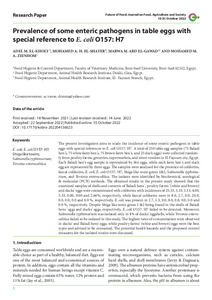| dcterms.abstract | The present investigation was designed to study the incidence of some enteric pathogens in table eggs with special references to E. coli O157: H7. A total of 250 table eggs samples (75 baladi hen ҆s, 75 white farm hen ҆s, 75 brown farm hen ҆s and 25 duck eggs) were collected randomly from poultry farms, groceries, supermarkets and street vendors in El Fayoum city, Egypt. Each baladi hen ҆s egg sample represented by five eggs, while each farm hen ҆s and duck eggs represented by three eggs. The samples were examined for the presence of coliforms, fecal coliforms, E.coli, E. coli O157: H7, Shiga like toxin genes 1&2, Salmonella Typhimurium and Yersinia enterocolitica. Isolates were identified by biochemical, serological & molecular (PCR) methods. The obtained results in the present study revealed that the examined samples of shells and contents of Baladi hens ҆, poultry farms ҆ (White and Brown) and Ducks ҆ eggs were contaminated with Coliforms with incidences of 25.33, 5.33, 1.33, 4.00, 5.33, 0.00, 0.00 and 2.66%, respectively, while, Fecal coliforms were in 8.0, 2.7, 0.0, 20.0, 0.0, 0.0, 0.0 & 0.0 %, respectively, Ecoli was present in 2.7, 1.3, 0.0, 8.0, 0.0, 0.0, 0.0 & 0.0 %, respectively. Despite of Shiga like toxin genes 1&2 were found in shells of Baladi hens ҆ eggs and Ducks ҆ eggs, respectively, E. coli O157: H7 was failed to be detected. Moreover, Salmonella Typhimurium was isolated only in 4% of Ducks ҆ eggs shells, while, Yersinia enterocolitica was failed to be isolated in this study. Highest rates of contamination were observed in Ducks ҆ and Baladi hens ҆ eggs, while, poultry farms ҆ (White and Brown) eggs were the best type and advised to be consumed. The potential health hazards and the suggested control measures of the isolated strains had been discussed. | eng |


